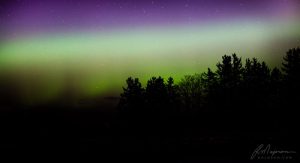
People & Culture
How to photograph the northern lights at lower latitudes
This photog lives in southern Ontario, but still gets amazing photos of the northern lights. Here’s how.
- 1777 words
- 8 minutes
This article is over 5 years old and may contain outdated information.
Travel

Medieval castles, rugged coastline and charming towns. Northern Ireland – a country of the United Kingdom located in the north-east of the island of Ireland – has a lot to offer to travellers seeking unique and memorable adventure. For decades in the late 20th century, Northern Ireland’s political turmoil cast a shadow over its tourism industry, but visitors who only visit the Republic of Ireland are missing the north’s rich history, geological heritage, and stunning natural beauty.
Your journey into rural Northern Ireland can follow the Coastal Causeway Route, one of the most scenic drives in Europe. Stretching nearly 200 kilometers between the cities of Belfast and Londonderry, the road hugs the coast of North Channel between Northern Ireland and Scotland (but also includes nine inland scenic drives), and offers views of vivid contrasts: emerald green hills, coastal cliffs, and lapping dark water. Here’s a taste of what’s in store.
A good launching point for your journey is Belfast’s Merchant Hotel, a luxury establishment housed in a former bank with an Italianate sandstone exterior dating from the mid-19th century. The hotel itself has a split personality, history-wise. The original 21 rooms in the hotel are Victorian in style with bespoke furniture and silk curtains. You will feel transported back in time in “The Great Room,” a restaurant housed within the original Victorian interior of the bank, which has a cathedral-like ceilings, a glass cupola and Ireland’s largest chandelier.
In 2010 the hotel’s multimillion dollar expansion added 36 Art Deco inspired rooms that recall the glamour of the roaring twenties and Great Gatsby—with Hollywood-style vanity sets, mirrored cabinets, and Corbusier wrap-around chairs. The spirit of the Art Deco rooms is echoed in the glossy red leather couches of “Berts Bar,” the hotel’s jazz club and restaurant.

From the quiet coastal town of Balleycastle, be sure to take a ferry to Rathlin Island, the northernmost point in Northern Ireland. Rathlin is only home to about 150 people, but is a special conservation area and home to Northern Ireland’s largest seabird colony—including guillemots and puffins. The observation area at the West Light Seabird Centre offers dramatic coastal views and a cacophony of bird sound.

Buses navigate the small island, but it is also hikable or bikable; near the island’s port you can lay in tall grasses overlooking flats where seals sun themselves. On the ferry back from the island dolphins can be seen playfully chasing the ship back toward Ballycastle, which is home to a number of bed and breakfasts—including the simple but well-kept “Ard Na Mara” on Atlantic Avenue.
Waking from Ballycastle for a new day’s journey, it is only a short detour inland to visit “The Dark Hedges,” an avenue of centuries-old beech trees that achieved international fame as a filming location for the TV show Game of Thrones.

Rejoining the Coastal Causeway route, those who do not fear heights should visit the Carrick-a-Rede rope bridge near Balintoy, a site maintained by the UK’s National Trust. A twenty-meter suspension bridge connects the tiny island of Carrikarede with the mainland; visitors who approach the bridge and turn back can do so without shame—but those are successful at crossing are afforded beautiful views of both Rathlin Island and limestone cliffs.
Continue your day’s journey with a visit to the Giant’s Causeway, a UNESCO world heritage site and a geologic wonder—tens of thousands interlocking, polygonal basalt columns forged by volcanic activity some 50 million years ago. Visitors are allowed to wander over the columns, which are arranged in tiered, pipe-organ-like patterns; they have inspired myths, poetry and art.

A good place to end a day of geologic exploration is found in the seaside resort town of Portstewart, which offers views of prolonged, northern-latitude sunsets in late summer.

The town is also one of unexpected culinary delights. Locals particularly praise Harry’s Shack in Portstewart. The chef there prepares special meals with locally-grown vegetables, though seafood is their speciality.
And Portstewart’s Strandeen Bed and Breakfast is also lucky to have a nutritionist as their proprietor; breakfasts included not only porridge with flax seeds and blueberries but delicious avocado toast with watercress.

From Portstewart, it is only an hour’s drive to the city of Derry/Londonderry, a flashpoint of political turmoil through the years between the “unionists”—the mostly protestant population who want Northern Ireland to remain part of the United Kingdom—and the mostly Catholic population of “republicans” who don’t. But “The Troubles,” the violent period of conflict between the Irish Republican Army and unionists between 1968 and 1998 is now history, and there are signs everywhere of peaceful coexistence. The Playhouse Theatre, a community arts center, has staged several productions that have promoted dialogue between the two communities. The new pedestrian Peace Bridge, over the River Foyle, has improved relations between what had traditionally been divided communities—and the use of that bridge has been helped by the recent opening of the Walled City Brewery, a microbrewery and restaurant, on the largely republican side of the Foyle that offers views back toward the city center.

Derry’s resurgence as a tourist destination is reinforced by the recent opening of the luxury Bishops Gate Hotel, whose lobby is worth peeking into just to see the whimsical Victorian-style portraits of dogs in formal wear. Derry’s city center is the last completely walled city in Ireland—the work of 17th century Scottish and English settlers—and it has an intimate, old-world feel.

As you wend your way back from Derry toward the Republic of Ireland, there are areas that are so rural that you might not encounter another human soul (or car) for long periods—though you might stumble upon occasional signs of ancient life, like the Beaghmore Stone Circles near Cooktown, which are thought to be more than three millennia old, and whose meaning is still largely a mystery to archaeologists and anthropologists.


A perfect end to your journey can be found at the rural Finn Lough Resort on Northern Ireland’s western coast, a gem which is nestled on the banks of a lake. The resort offers a series of lakeside cottages, a full-service restaurant, and activities like kayaking—but its new show stealers are a series of new transparent bubble domes set in a forested area that allow you to take a bath, sleep and gaze at the stars in completely privacy. The resort is also an hour’s drive from the Marble Arch Caves Geopark, a dramatic show cave in the foothills of Cuilcagh Mountain that in good weather can be entered by a small boat ride.
Northern Ireland deserves to be seen as much as a tourist destination as the Republic. Visitors who fly into Dublin can know that they are doing themselves a favor by venturing north.
Don’t have time to venture north on the island? Explore the Republic of Ireland in the video below.
Are you passionate about Canadian geography?
You can support Canadian Geographic in 3 ways:

People & Culture
This photog lives in southern Ontario, but still gets amazing photos of the northern lights. Here’s how.

Travel
Jill Doucette, founder and CEO of Synergy Enterprises, shares insights on new trends in the tourism industry and why there’s reason to be optimistic about a sustainable future for travel

Exploration
A behind-the-scenes look at the adventures and discoveries of the passionate explorers funded by the Royal Canadian Geographical Society

Environment
Tracking the country’s extreme weather events to answer the question: are storms getting worse?